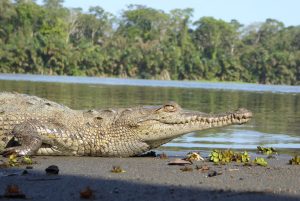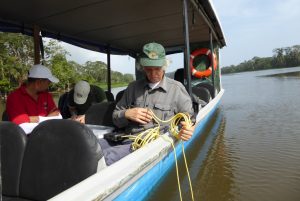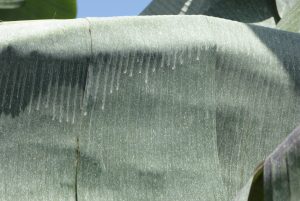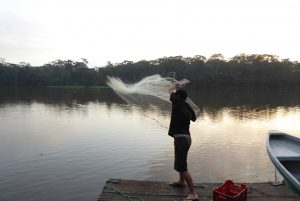In this series of posts, Carsten Brühl reports about his current trip to Costa Rica. Part 4 is all about his visit of the Laguna de Madre Dios, where researchers sample water and fish to analyse for pesticide residues originating from upstream banana and pineapple plantations.
We just returned from a field trip to the Laguna de Madre Dios at the Atlantic coast that is situated south of Tortugero National Park. The lagoon is collecting water from a canal system that runs along the Caribbean coast and the Rio Madre Dios and is connected to the sea. This leads to changes in salinity levels and water table and therefore creates a unique habitat with all kinds of freshwater and marine organisms such as dolphins, manatees and crocodiles.
The lagoon is also the end of a catchment that is running through lowlands dominated by banana and pineapple plantations, both high in pesticide applications. With tropical rainfalls residues from the plantations are drained into a system of canals in the streams and rivers that end in the lagoon. In the last decade, many fish kills were noted and brought to the attention of the public by local people, coming along with protests from fisherman in the capital San Jose.
Following these incidents, The Regional Institute for Studies on Toxic Substances (IRET) and Universidad Nacional de Costa Rica jointly started a large-scale monitoring program to measure biodiversity in different habitats, during which they also gained detailed knowledge of the hydrology of this complex water body. Colleagues from IRET analysed pesticide occurrence in water and fish, and established a sophisticated sampling scheme.
I took the chance and went along with Clemens Ruerpert and Freylan Mena to take samples. On our way we passed through the banana plantations and had a look at the planting scheme, the canals and also the spray residues that were visible by the naked eye. We were expected by Julio who took us through the canals to the Rio Madre Dios into the lagoon by boat, pointing out howler monkeys, fish eagles, sloths and basilisk on the way. We stayed at his hostel on the banks of the lagoon where you can see many birds, crabs and crocodiles.
The first samples were taken and we also visited the Pacuare Nature Reserve, just opposite Julio’s cabins, where Oropendula birds were building a large breeding colony, and all kinds of marine turtles come to breed. In the morning, Freylan was catching fish for residue sampling, and after breakfast we took some more water samples in the lagoon and also on our way back along the river. This tropical marine and freshwater ecosystem is constantly under a threat of pollution by pesticide runoff and plastic waste from the upstream plantations and more attention should be given to conserve this pearl of Costa Rica’s biodiversity.





